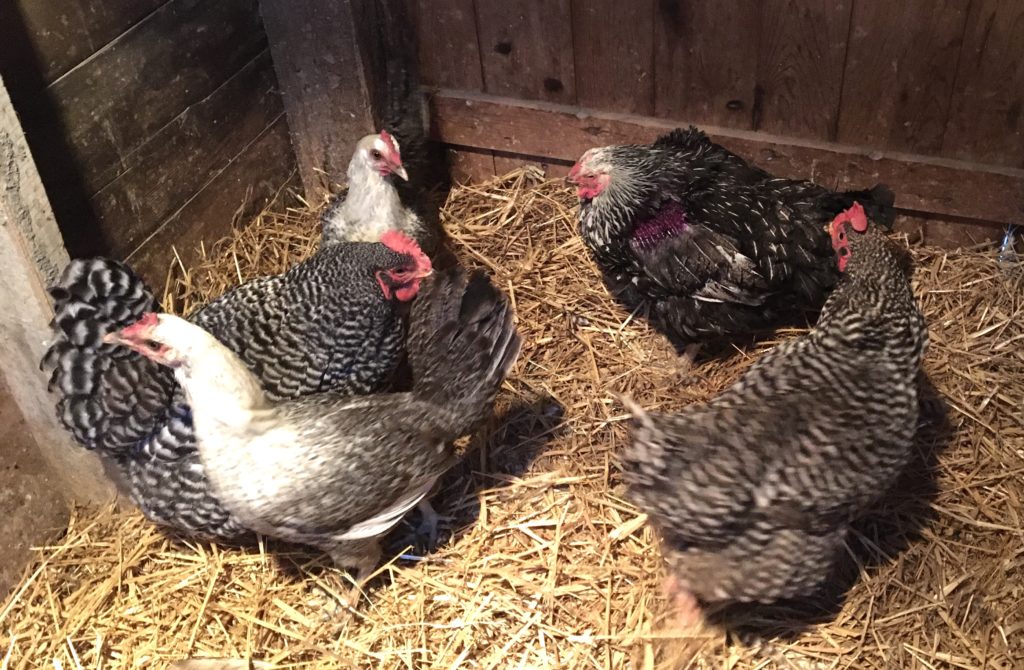It’s a blue-stained Christmas on Rusty Metal Farm

It’s looking like a blue Christmas here on Rusty Metal Farm. Not blue as in sad or melancholy, though. Blue in color. And in true Rusty Metal Farm fashion, it involves one of my critters, some home first-aid and a lack of reading all the instructions on my part. In other words, just another day here on the farm.
It started awhile back when I noticed that my elderly chicken Shoppie had not grown feathers back in a couple of patches after the fall molt. Shoppie, as some readers may remember, is so-named because she has spent a lot of time convalescing from various injuries and illnesses in my heated shop over the years.
She is my special chicken who increasingly appears to be a step or two behind her coop-mates. When I toss treats to them, it takes Shoppie a minute or two to realize there are goodies literally at her feet. It’s a fact not lost on the younger chickens who are more than happy to swoop in and grab them.
Some days I see her out in the yard standing still and then, for reasons known only to her, she starts slowly turning around in place, flapping her wings. I call it her chicken interpretive dance.
But for all of that, she is a happy, otherwise healthy chicken who is long retired from egg-laying duties. And, for the most part, the other gals leave her alone in her own Shoppie world.
But those bald patches worried me. Chickens, for all their cute feathered fluffiness, can be horribly aggressive if one of their flock-mates has an injury. All it takes is one small sore or cut on one chicken to trigger a shark-like frenzy among the other birds. They will gang up on the injured chicken and peck and peck at the injury. I have seen a chicken pecked to death, and it is not pretty.
Fortunately, there are steps that can be taken. Separating the injured chicken from the rest of the hens is one option. Another is using something called Blue Kote, a topical antibiotic that not only promotes the healing and drying of an injury, it creates a protective coating that prevents whatever it is that triggers that pecking attack.
So the other day, I decided to take preventative action. At this point, it’s important to note that I have used Blue Kote in the past, but the bottle of liquid had run out. When I re-ordered a new container, I opted for the spray-can version, figuring spraying it on had to be easier than trying to dab it on with a cotton ball.
Yeah, it was a case of hen hubris.
I gave the instructions on the container a quick read — it explained how to open the cap, how to aim and other information I should have taken the time to read and retain. Like how it’s a good idea to use gloves and how thoroughly the Blue Kote can stain furniture, clothing and skin.
Stuffing the can into one pocket and my gloves in the other, I headed out to the coop. Inside the chickens were hanging out and a bit bored as it’s been too cold recently to let them range outside.
Shoppie was napping in a corner, so I figured it would be a simple matter to sneak up on her, grab her and apply the Blue Kote.
Nope, the moment I took a step all the other chickens decided as a group I was up to no good and began running in flapping, squawking circles around my feet. Except for the two Egyptian Fatimahs, which can fly and look very prehistoric, who decided to flap and squawking while flying around my head. It was like “Jurassic Park” meets “Chicken Run” meets “Sharknado.”
All the excitement woke Shoppie up. For an old chicken, she is impressively fast and nimble on her feet. But, somehow, I was able to survive the ongoing frakas going on around me and catch her.
Holding her to my chest with one hand, I dug the can of Blue Kote out of my pocket with the other. Positioning Shoppie to best expose the largest of the bald patches, I aimed and sprayed. I am happy to report the bald spot got coated. But so did my ungloved hand.
My mind immediately flashed to the warnings on the can and, as I silently cussed and berated myself for ignoring them, I dug out my gloves and managed to put them on, all while still holding on to an increasingly annoyed chicken.
Within a few moments, I was done. The bald patches were covered, and Shoppie was back down on the coop floor glaring at me. She then marched off to her corner and began preening her feathers that I had disturbed in the whole process.

Back inside my house, I went to the kitchen sink to try and wash the blue off my left hand. It took some scrubbing with a face cloth — which is now blue, along with the towel I used to dry my hands — but most of it came off. I figure the rest will wear off in time.
Until then, Shoppie and I have our unseasonably blue patches for the holidays. I can only imagine that means we are in for a colorful Christmas here on the farm.
From all of us on Rusty Metal Farm, the very happiest of holidays!
